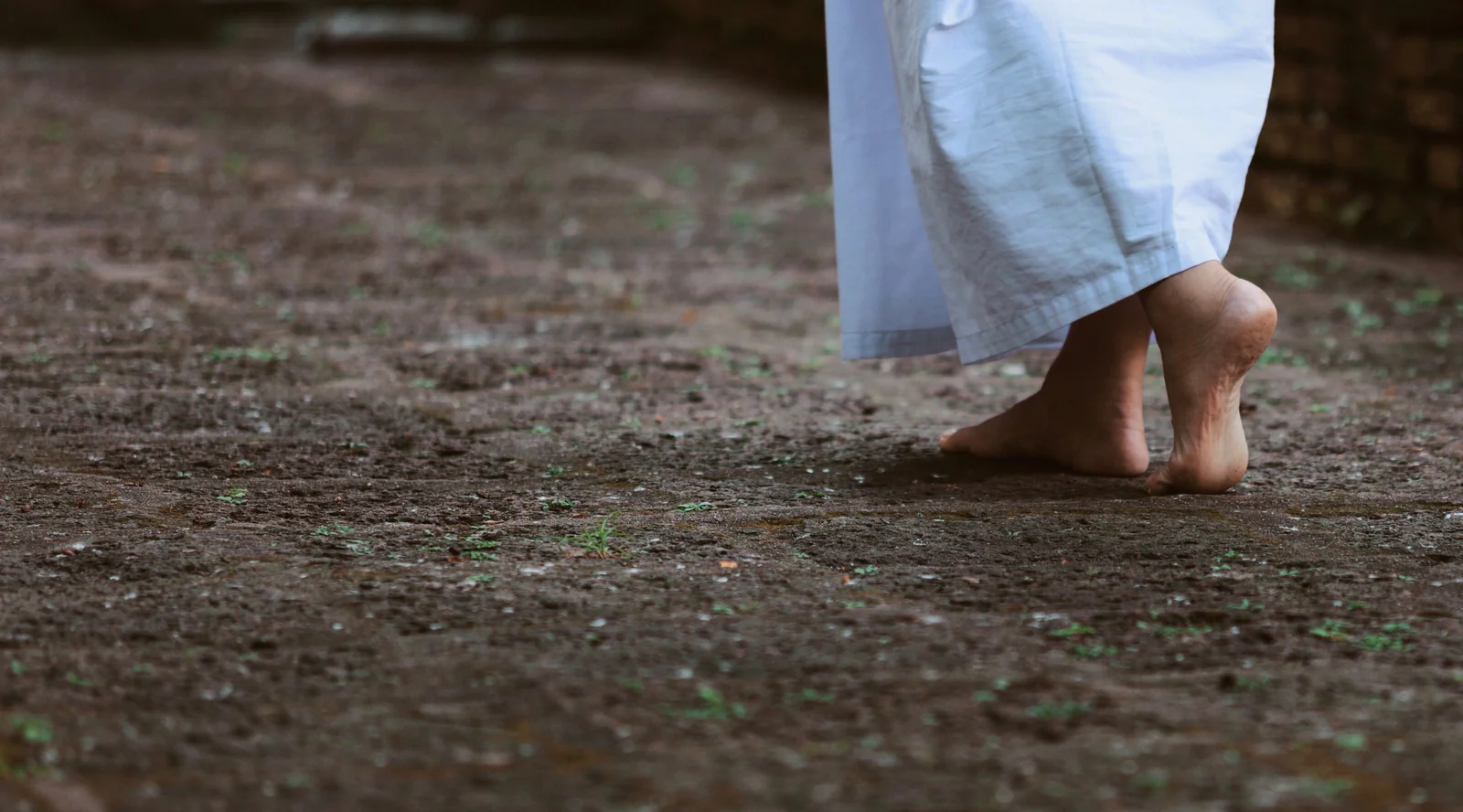Walking meditation is a mindfulness practice that involves walking slowly and intentionally, while focusing on the present moment. It is a form of meditation that combines physical activity with mental focus, helping to cultivate a sense of calm and inner peace.
Definition of Walking Meditation
Walking meditation is an ancient practice that has been used by many spiritual traditions around the world. In its essence, walking meditation involves paying attention to the sensations in your body as you walk, staying present with each step and breath.
The practice emphasizes mindfulness, which means being fully aware of your thoughts, feelings and senses without judgment. This is why it can be such an effective way to reduce stress and anxiety: by focusing on the present moment and letting go of worries about the future or regret about the past.
Brief History of Walking Meditation
The origins of walking meditation can be traced back to Buddhist monks in ancient China who used it as a way to meditate during long retreats. The practice was later adopted by other Buddhist traditions, including Zen and Vipassana.
In Japan, there is a form of walking meditation known as kinhin which is practiced as part of Zen Buddhism. In this tradition, practitioners walk silently around a room in a slow, deliberate manner while focusing on their breath.
In recent years, walking meditation has become more popular in the West as people seek out new ways to manage stress and improve their mental health. While it originated in spiritual contexts, it is now often taught in secular settings such as yoga studios or mental health clinics.
Importance of Mindfulness in Today’s World
In today’s fast-paced world where we are constantly bombarded with information from technology and social media platforms, it can be difficult to stay present and focused. This is where mindfulness practices like walking meditation can be particularly helpful.
By tuning into our bodies and being fully present with each moment, we can cultivate a deeper sense of inner peace and clarity. This can help us better manage stress and anxiety, improve our relationships with others, and lead a more fulfilling life overall.
Mindfulness is also increasingly recognized as an effective tool for treating mental health issues such as depression and anxiety. By focusing on the present moment rather than ruminating on negative thoughts or worries about the future, we can improve our overall well-being.
The Benefits of Walking Meditation
Walking meditation is a form of mindfulness practice that involves being fully present and aware of each step taken during a walk. It has been practiced for centuries, particularly in Buddhist traditions, and has gained popularity in recent years as a way to reduce stress, increase focus, and promote overall well-being. In addition to its spiritual benefits, walking meditation offers a range of physical and mental benefits that can improve overall health.
Physical Benefits
Walking meditation can provide numerous physical benefits. One of the most notable is improved cardiovascular health.
Regular practice has been shown to lower blood pressure, reduce the risk of heart disease and stroke, and improve circulation. Walking regularly can also help strengthen muscles and bones.
This is especially important for older adults who are at risk for osteoporosis or muscle loss. Another benefit is increased flexibility and balance.
Walking mindfully requires paying close attention to each movement, which helps maintain joint mobility and improve balance. This reduces the risk of falls among older adults while also improving athletic performance among athletes.
Mental Benefits
In addition to physical benefits, walking meditation provides significant mental advantages as well. It can help reduce stress and anxiety by promoting relaxation through deep breathing exercises as well as focusing on the present moment instead of worrying about future events.
Walking mindfully also improves focus and concentration by training the brain to remain alert while tuning out distractions like noise or other stimuli from outside sources.
This improvement translates into better productivity at work or school. Walking meditation promotes creativity by encouraging divergent thinking – the ability to generate many ideas from one starting point – which leads to innovative solutions in problem-solving tasks.
Spiritual Benefits
Beyond physical and mental advantages, walking meditation also offers spiritual benefits such as increased self-awareness that comes with being mindful in every moment while walking; this includes understanding our own thoughts and emotions as well as those of others around us.
Walking also allows us to connect to nature, which can help us feel more grounded and peaceful. When we walk mindfully, we are in touch with the natural world around us, observing the beauty in all things – from the colors of flowers to the sound of birds – and feeling a deeper sense of gratitude for life itself.
Walking meditation offers numerous benefits that enhance overall health and well-being. By taking a mindful approach to walking, practitioners can reduce stress levels, improve focus and creativity, strengthen muscles and bones, increase flexibility and balance, boost cardiovascular health, deepen their sense of self-awareness while connecting closely with nature.
Walking Meditation Techniques
Choosing a Location for Walking Meditation
Choosing the right location is crucial for the success of your walking meditation practice. Ideally, you want to find a place that is quiet, peaceful, and free from distractions. A park or a garden is a great option as it allows you to connect with nature while enjoying fresh air.
If you prefer indoor locations, consider finding a quiet room or hallway in your home. Once you have found the perfect spot, make sure that it is safe and comfortable to walk around.
Avoid areas with uneven terrain or potential hazards such as traffic or water bodies. Also, make sure the area is not too crowded as this can be distracting.
Preparing for the Walk
Before starting your walking meditation practice, it’s important to prepare yourself mentally and physically. Wear comfortable clothing and shoes that allow your feet to breathe and move freely. It’s also recommended that you carry water in case you get thirsty during your walk.
Take a few deep breaths and clear your mind of any thoughts or worries before beginning. You may also choose to set an intention for your practice such as focusing on gratitude or self-awareness.
Starting the Walk
To start your walking meditation practice, stand tall with good posture and take a few deep breaths in through your nose and out through your mouth. Begin by taking slow steps forward while maintaining awareness of each movement of your body.
Pay attention to how each step feels – notice how the ground feels beneath you, how each muscle moves as you take another step forward. Focus on being present in this moment without any judgment towards yourself or others.
Maintaining Focus During the Walk
As you continue walking, maintain focus on each physical sensation associated with every step – feel the weight shifting from one foot to another; notice any tension in your body and release it. If your mind wanders, bring it back to the present moment by refocusing on your breath or the physical sensations of walking.
You may also choose to use a mantra or visualization technique during your walk. For example, you could repeat a phrase such as “peace and calm” with each step or imagine yourself surrounded by a white light of positive energy.
Ending the Walk
When you are ready to end your walking meditation practice, gradually slow down your steps until you come to a complete stop. Take a few deep breaths and reflect on how you feel both physically and mentally. You may choose to end with gratitude or repeat a positive affirmation before concluding the practice.
Remember that walking meditation is not about achieving any particular goal but rather about being present in the moment and connecting with yourself at a deeper level. With consistent practice, you can cultivate mindfulness in all aspects of life leading to increased peace, clarity, and happiness.
Tips for Practicing Walking Meditation Regularly
One of the most important aspects of practicing walking meditation regularly is setting aside a specific time each day for the practice. Consistency is key when it comes to building a habit, and meditation is no exception.
Setting aside time for regular practice
Choose a time that works best for you, whether it’s in the morning, during your lunch break, or in the evening before bed. It’s important to find a consistent time so that you can make this part of your daily routine.
Once you’ve chosen a specific time, set aside at least 10-15 minutes each day for your walking meditation practice. This may not seem like a lot of time, but it can be incredibly impactful with consistent practice over time.
Creating a comfortable environment
Creating a comfortable environment for your walking meditation practice can help to make it more enjoyable and sustainable over the long term. Consider finding an outdoor location that feels peaceful and calming to you, such as a nearby park or nature reserve. Alternatively, if outdoor spaces are not easily accessible or comfortable for you, try creating an indoor space that feels calming and inviting.
When setting up your space, consider using props such as cushions or blankets to create comfort while sitting or standing during your meditation practice. You may also want to use aromatherapy oils or candles to enhance relaxation and focus during your meditation.
Staying committed to the practice
Staying committed to any new habit can be challenging at times, but with mindfulness practices like walking meditation there are some strategies that can help keep you on track.
One effective strategy is tracking progress through journaling or making notes after each session about how you felt during and after the practice. Another strategy is joining community groups online or in person who share similar interests in mindfulness practices like walking meditation.
Being a part of such groups can help to keep you motivated and accountable to sticking with your daily practice. Be gentle and kind with yourself if you miss a day or two of your practice.
Remember that building habits takes time and consistency, and beating yourself up over missed days will not help. Instead, just pick up where you left off the next day and keep moving forward with your daily walking meditation practice.
Conclusion
Summary of benefits discussed in the article
In this article, we have discussed the many benefits of walking meditation. It is a practice that has been around for centuries and is still relevant today.
Walking meditation can improve cardiovascular health, strengthen muscles and bones, increase flexibility and balance, reduce stress and anxiety, improve focus and concentration, enhance creativity, increase self-awareness, create a greater connection to nature, and deepen a sense of gratitude. These physical, mental, and spiritual benefits are why walking meditation is such an excellent practice to incorporate into your daily routine.
Encouragement to try walking meditation as a daily practice
If you have not yet tried walking meditation as part of your mindfulness practice or exercise routine, we encourage you to do so. Walking meditation can be done anywhere that is safe to walk and provides ample space for movement.
Whether it’s on a city sidewalk or in a natural setting such as a park or beach trail. Remember that the goal of walking meditation isn’t just to walk but also to be mindful while doing so.
At first, it may feel awkward or even uncomfortable because it involves slowing down from our fast-paced lives; however when we begin taking each step with awareness then becomes easier over time until eventually becomes second nature! Start small by practicing for 10-15 minutes at first then gradually increasing duration as you get more comfortable with the practice.
Incorporating Walking Meditation into your daily routine has numerous health benefits both physically and mentally which can significantly improve everyday life quality! You don’t need any special equipment other than comfortable shoes & clothing along with an open mind & willingness make this an enjoyable experience that will leave you feeling refreshed rejuvenated & more mindful throughout the day!




























































